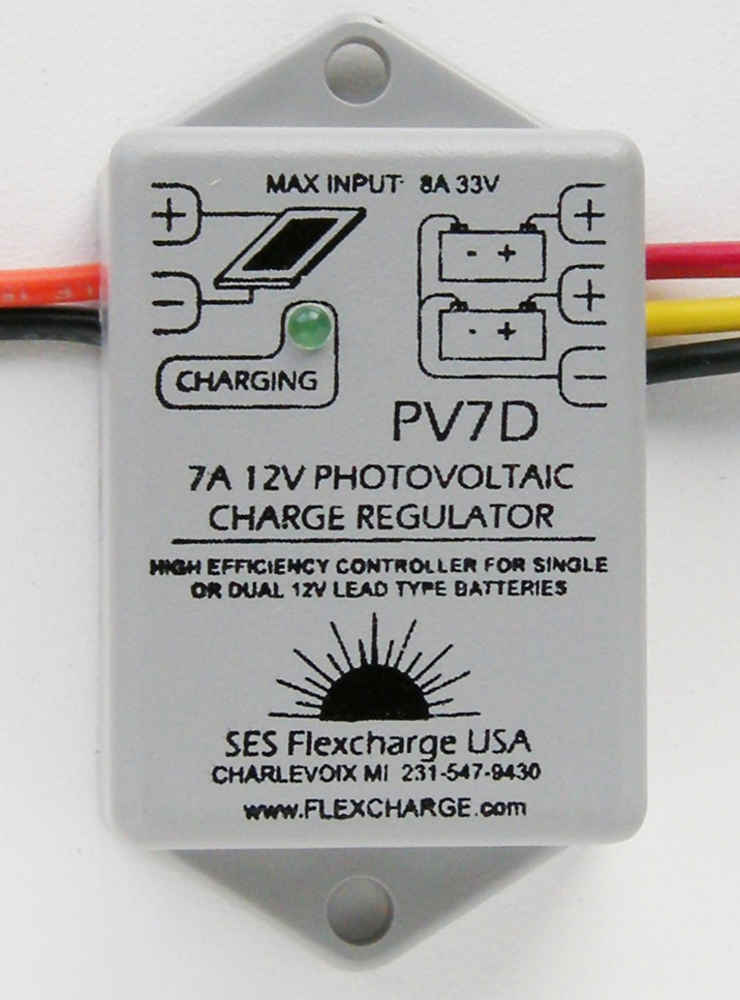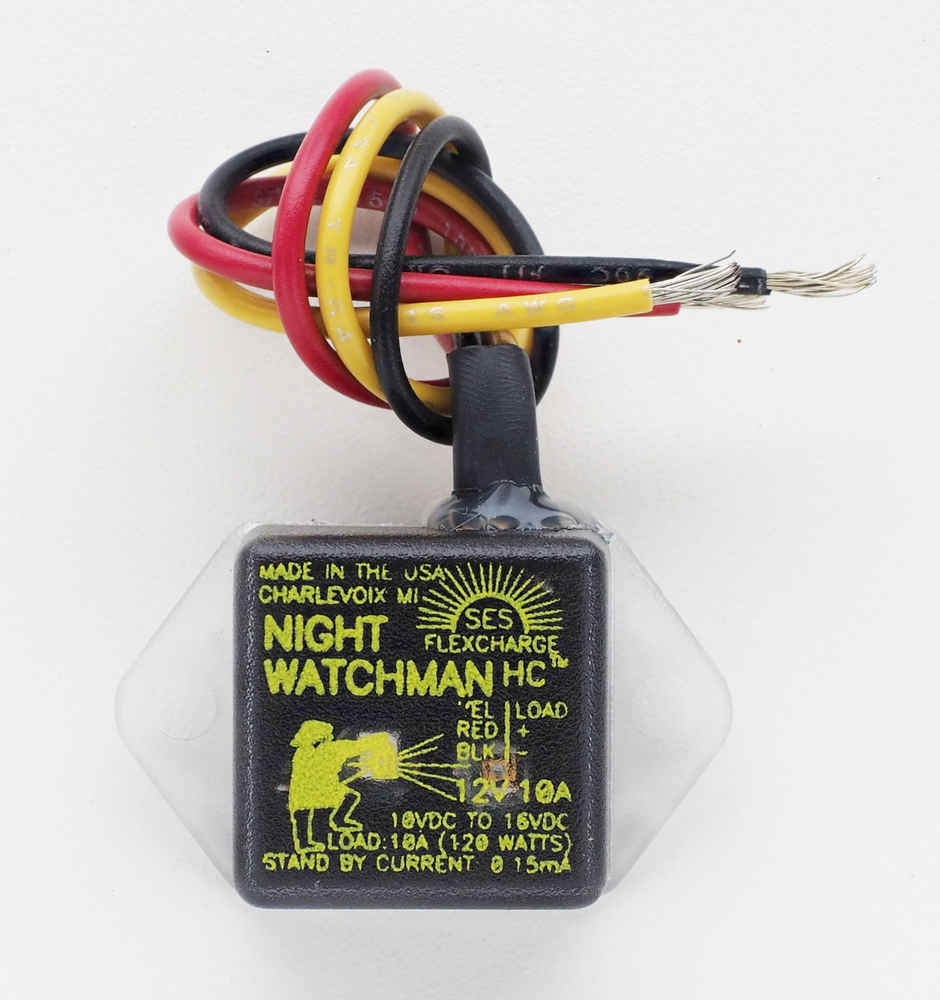Flexcharge Controllers
Flexcharge™
Flexcharge™ Products and Accessories
Suitable for GEL, AGM, and Flooded Lead Acid Batteries.
Note: Flexcharge Charge controllers will not control Lithium Batteries
Please call J Gordon & Co for more information and pricing
410-263-0054
Flexcharge™ NC25A Ultra High Efficiency Charge Controller (Regulator)

NC25A Ultra High Efficiency 25 Ampere Solar and Wind System Charging System Controller
For Lead Acid GEL, AGM, and Flooded cell Batteries. Also works with wet cell NiCad batteries. Do not use on Lithium batteries of any type.
The NC25A-(X) is series regulator designed for alternative energy charging systems ranging in size from 0.1A to 25A. It is the ideal regulator for Solar (PV) and Permanent Magnet Generators (Including outboard motors and smaller wind generators). The NC25A also includes the Charge Divert feature. Charge Divert allows you to use the excess charging source energy for other tasks, or for placing a load on permanent magnet charging sources such as wind generators to prevent over speed conditions. The Divert connection is only activated after the charging source is making energy and the batteries are not using the energy (i.e. A wind generator will not be starting into the divert load). Divert Resistor This controller can easily and inexpensively be expanded to handle one or more banks of 100A charging sources. (1000A max charging current in this configuration). Multiple battery banks can be charged with the use of a standard battery charging isolators.
Years prior to the sale of the first NC25A, the SES Flexcharge product development team took a hard look at what a new alternative energy charge controller's performance level would need to be to give the user the best possible controller for there needs. From that effort came the following design criteria;
Most alternative energy charge controllers operate at an efficiency of 97%. Off hand, this sounds pretty good but lets go through the numbers for a typical charge controller.
The NC25A operates at 99.5% typical charging efficiency. (99.9% at its best).
P = 25A x 0.005 x 12.6V = 1.57W
In comparing the numbers we see a 11 watt gain in charging energy that is available for your battery bank with the NC25A over the Typical Charge controller.
Question: How much does an 11W solar panel cost? This is precisely why controller efficiency is so critical.
With a peak charging efficiency of 99.9% and an operating current of only 4mA, more of the systems charging energy will get through a NC25A into your batteries than with any other regulator on the market. Models are available for charging 12V, 24V, 36V, and 48V systems. Use with Lead Acid, Gel, or Flooded Nicad battery technologies.
Dependability
There should never be such thing as a compromise to dependability when it comes to an alternative energy system charge controller as these systems are often located in hard to reach locations (mountain tops, ocean navigation buoys, polar regions, etc...). We took great care to design the NC25 for long term unattended operation; extensive transient voltage protection; high steady-state voltage protection (it is not affected by continuous charging input voltages up to 100V, the point where the transient voltage protection kicks in); reverse polarity protection on battery connections; fully sealed electronics for 100% humidity operation; etc... The NC25A is designed for Install and Forget operation.operation; etc...
Simple to Operate
The NC25A includes easy to read Charge and Divert Indicators, an adjustment for peak charge voltage, and an easy to use terminal strip for the system wire connections. Because the system charge controller is usually located near the battery bank in a remote structure we chose not to incorporate power consuming monitors such as volt meters or current monitors. If this type monitoring equipment is desired it should be installed after the system disconnect switch and located where you can view them.
Easy Upgrades Expansion Kits
Upgrading the controller to regulate higher currents can be accomplished easily, and is relatively inexpensive see page 21 in the manual at NC25a Manual 2012.pdf See special instructions for converting the NC25A to a high amperage dump load controller NC25A DUMP LOAD CTL.pdf
Energy State Taper Charge Process
This graph describes the charging process used by all Flexcharge controllers. It has many benefits including greatly reduced gassing during charging and it allows for micro-equalization of Lead acid as well as sealed Gel and AGM battery technologies. Click on the link for more details.
Flexcharge™ PV7D Charge Controllers For Photovoltaic Charging Systems

The PV7D (for Dual and Single battery banks) is a cost effective shunting regulator designed for smaller 12V Solar Only applications with a maximum solar charging current of 7A. Special order 6V or 24V units. These controllers are easily expandable to handle charging currents from 35 to 500A. We have engineered these controllers to be extremely efficient, accurate, salt water spray resistant, and very small (1.5" x 2"). It is Ideal for use in a marine environment. Use with Lead Acid AGM or Gel battery technologies. Like the NC25A they also use only 4mA to operate the circuitry. The PV7D controllers are not to be used with outboard motors or any generator based charging system. For Lead Acid GEL, AGM, and Flooded cell Batteries. Do not use on Lithium batteries of any type
The PV7D are a all solid state design using the highest efficiency components. No heat sink is required on the PV7 because almost no heat that is generated in the high efficiency solid state components.
We took great care to design the PV7D for long term unattended operation; extensive transient voltage protection; high steady state voltage protection (it is not affected by continuous charging input voltages up to 33V, the point where the transient voltage protection kicks in); fully sealed electronics for 100% humidity operation; etc... The PV7D is designed for Install and Forget operation.
Simple to Use
The PV7D includes an easy to read Charge Indicator. The peak charge voltage is factory set so there are no user adjustments to contend with working with all lead acid battery types. System wire connections are made by connecting to the controllers four wire pigtails, either by soldering or on a owner supplied terminal strip.
Easy Upgrades
Upgrading the controller to regulate many hundreds amperes can be accomplished easily and is relatively inexpensive. Contact Flexcharge for details.
Energy State Tape Charging Charging Algorithm Explained. This is the charging process used by all Flexcharge controllers. It has many benefits including greatly reduced gassing during charging, and it allows for micro equalization of Lead acid as well as Gel battery technologies. Click on the link for more details.
Flexcharge™ Night Watchman Dusk To Dawn Controller

This unique product was started as the pet project of our chief engineer at Flexcharge. As a cruising sailor he found that he was often thinking more about getting underway in the morning than turning the mast head anchor light OFF. This of course used a substantial amount of battery power lighting the lamp all day. The Night Watchman is designed to be mounted outside in a marine salt air environment. It is completely waterproof, and very small (1" x 1" x 1") for mounting in an inconspicuous location.
Because power consumption is always a concern on battery powered systems, (sail boats, PV systems, etc.) the Night Watchman is designed to use an extremely small amount of power in standby mode (only 0.00015A or 0.15mA), yet it is capable of supplying up to 10A of load current.
With boring repetition the Night Watchman will turn 12V incandescent, LED or fluorescent lights ON in the evening within a half hour of sunset, and OFF in the morning within a half hour of sun rise.
The Night Watchman's circuitry is designed to prevent flickering therefore it can be used to control 12V fluorescent lamps and all other lamp types including LEDs.
Feel free to go ashore during the day and stay all night. Your mooring light will turn ON and OFF protecting you vessel as required. Many applications have developed since the original marine use. Signs, yard lights, cabins, etc. Works on any load within the 10 amp rating including motors. Larger loads can be controlled by using a relay controlled by the Night Watchman. When used in conjunction with our 12 volt Programmable Timer you can have dusk to dawn control along with an OFF time during the night.
Other great uses for the Night Watchman
- Use for Boat, Cabin, and Spreader lights too
- 12V Motor Home / RV lights
- Yard and Porch 12 volt lights
- Solar lighting system's lamp controller
- Motor operation such as Chicken coop doors etc.
- Automatically turn ON low level lighting when Night Watchman senses that High level lighting in the area is turned OFF.

